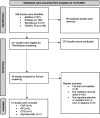Measurement properties of cervical joint position error in people with and without neck pain: a systematic review and narrative synthesis
- PMID: 38200520
- PMCID: PMC10777525
- DOI: 10.1186/s12891-023-07111-4
Measurement properties of cervical joint position error in people with and without neck pain: a systematic review and narrative synthesis
Abstract
Introduction: Proprioception can be impaired in people with neck pain. The cervical joint position sense test, which measures joint position error (JPE), is the most common test used to assess neck proprioception. The aim of this systematic review was to assess the measurement properties of this test for the assessment of people with and without neck pain.
Methods: This systematic review was registered prospectively on Prospero (CRD42020188715). It was designed using the COSMIN guidelines and reported in line with the PRISMA checklist. Two reviewers independently searched Medline, Embase, SportDiscus, and CINAHL Plus databases from inception to the 24th July 2022 with an update of the search conducted until 14th of October 2023. The COSMIN risk of bias checklist was used to assess the risk of bias in each study. The updated criteria for good measurement properties were used to rate individual studies and then the overall pooled results. The level of evidence was rated by two reviewers independently using a modified GRADE approach.
Results: Fifteen studies were included in this review, 13 reporting absolute JPE and 2 reporting constant JPE. The measurement properties assessed were reliability, measurement error, and validity. The measurement of JPE showed sufficient reliability and validity, however, the level of evidence was low/very low for both measurement properties, apart from convergent validity of the constant JPE, which was high.
Conclusion: The measure of cervical JPE showed sufficient reliability and validity but with low/very low levels of evidence. Further studies are required to investigate the reliability and validity of this test as well as the responsiveness of the measure.
Keywords: Measurement properties; Neck pain; Position error; Position sense; Proprioception; Sensorimotor.
© 2024. The Author(s).
Conflict of interest statement
The authors declare no competing interests.
Figures
Similar articles
-
Measurement properties of cervical joint position error in people with and without chronic neck pain.PLoS One. 2023 Oct 12;18(10):e0292798. doi: 10.1371/journal.pone.0292798. eCollection 2023. PLoS One. 2023. PMID: 37824590 Free PMC article.
-
Responsiveness of the cervical joint position error test to detect changes in neck proprioception following four weeks of home-based proprioceptive training.PLoS One. 2024 May 10;19(5):e0303066. doi: 10.1371/journal.pone.0303066. eCollection 2024. PLoS One. 2024. PMID: 38728251 Free PMC article.
-
Measures of neck muscle strength and their measurement properties in adults with chronic neck pain-a systematic review.Syst Rev. 2023 Jan 16;12(1):6. doi: 10.1186/s13643-022-02162-5. Syst Rev. 2023. PMID: 36642710 Free PMC article.
-
Influence of chronic neck pain on cervical joint position error (JPE): Comparison between young and elderly subjects.J Back Musculoskelet Rehabil. 2017 Nov 6;30(6):1265-1271. doi: 10.3233/BMR-169630. J Back Musculoskelet Rehabil. 2017. PMID: 28800305
-
Measurement Properties of the Craniocervical Flexion Test: A Systematic Review.Phys Ther. 2020 Jul 19;100(7):1094-1117. doi: 10.1093/ptj/pzaa072. Phys Ther. 2020. PMID: 32313944
Cited by
-
Cross-Cultural Adaptation, Reliability, and Validity of the Greek Version of the Fremantle Neck Awareness Questionnaire (FreNAQ-GR) in Patients with Chronic Neck Pain.Healthcare (Basel). 2024 Oct 5;12(19):1985. doi: 10.3390/healthcare12191985. Healthcare (Basel). 2024. PMID: 39408165 Free PMC article.
-
Instruments for measuring fatigue in patients with brain tumours: protocol for a COSMIN--based systematic review.BMJ Open. 2025 Jul 28;15(7):e098711. doi: 10.1136/bmjopen-2024-098711. BMJ Open. 2025. PMID: 40730408 Free PMC article.
-
Contextual and placebo effects of suboccipital myofascial release: evaluating its influence on pain threshold, cervical range of motion, and proprioception.BMC Musculoskelet Disord. 2025 May 21;26(1):502. doi: 10.1186/s12891-025-08741-6. BMC Musculoskelet Disord. 2025. PMID: 40399920 Free PMC article. Clinical Trial.
-
Reliability and Validity of the KFORCE Sens® Inertial Sensor for Measuring Cervical Spine Proprioception in Patients with Non-Specific Chronic Neck Pain.Brain Sci. 2024 Nov 22;14(12):1165. doi: 10.3390/brainsci14121165. Brain Sci. 2024. PMID: 39766364 Free PMC article.
References
-
- Revel M, Andre-Deshays C, Minguet M. Cervicocephalic kinesthetic sensibility in patients with cervical pain. Arch Phys Med Rehabil. 1991;72(5):288–91. - PubMed
-
- Wibault J, Vaillant J, Vuillerme N, Dedering Å, Peolsson A. Using the cervical range of motion (CROM) device to assess head repositioning accuracy in individuals with cervical radiculopathy in comparison to neck- healthy individuals. Man Ther. 2013;18(5):403–9. doi: 10.1016/j.math.2013.02.004. - DOI - PubMed
Publication types
MeSH terms
LinkOut - more resources
Full Text Sources
Medical


